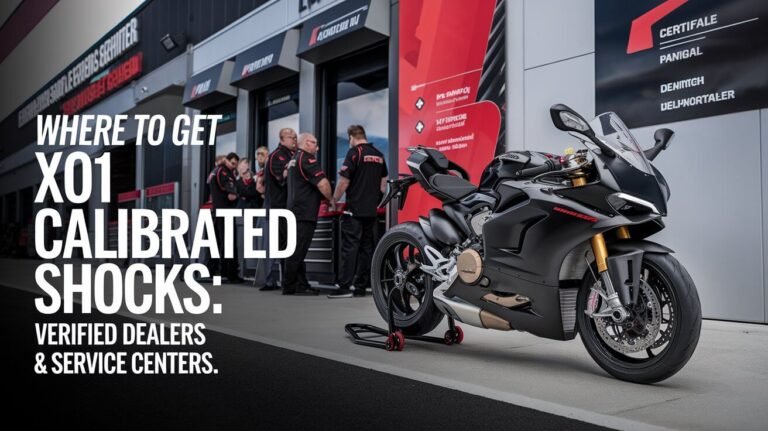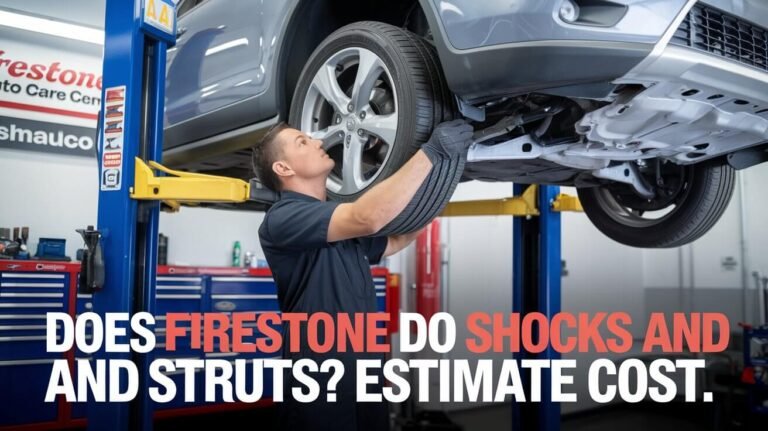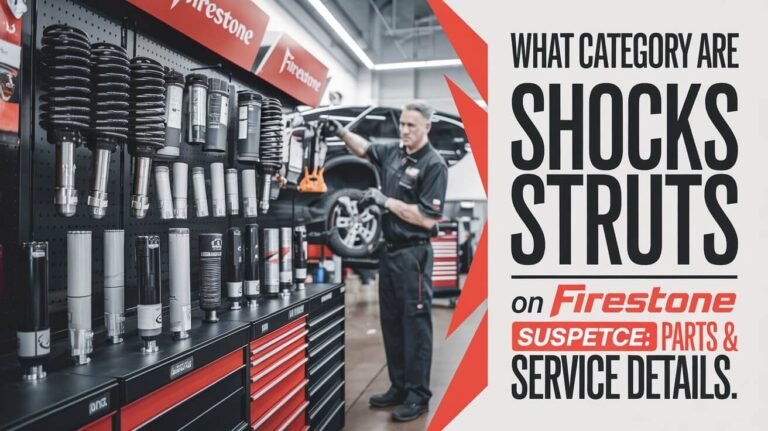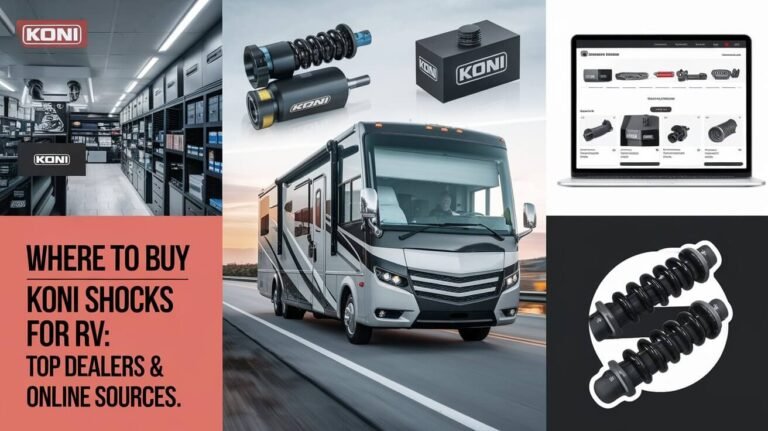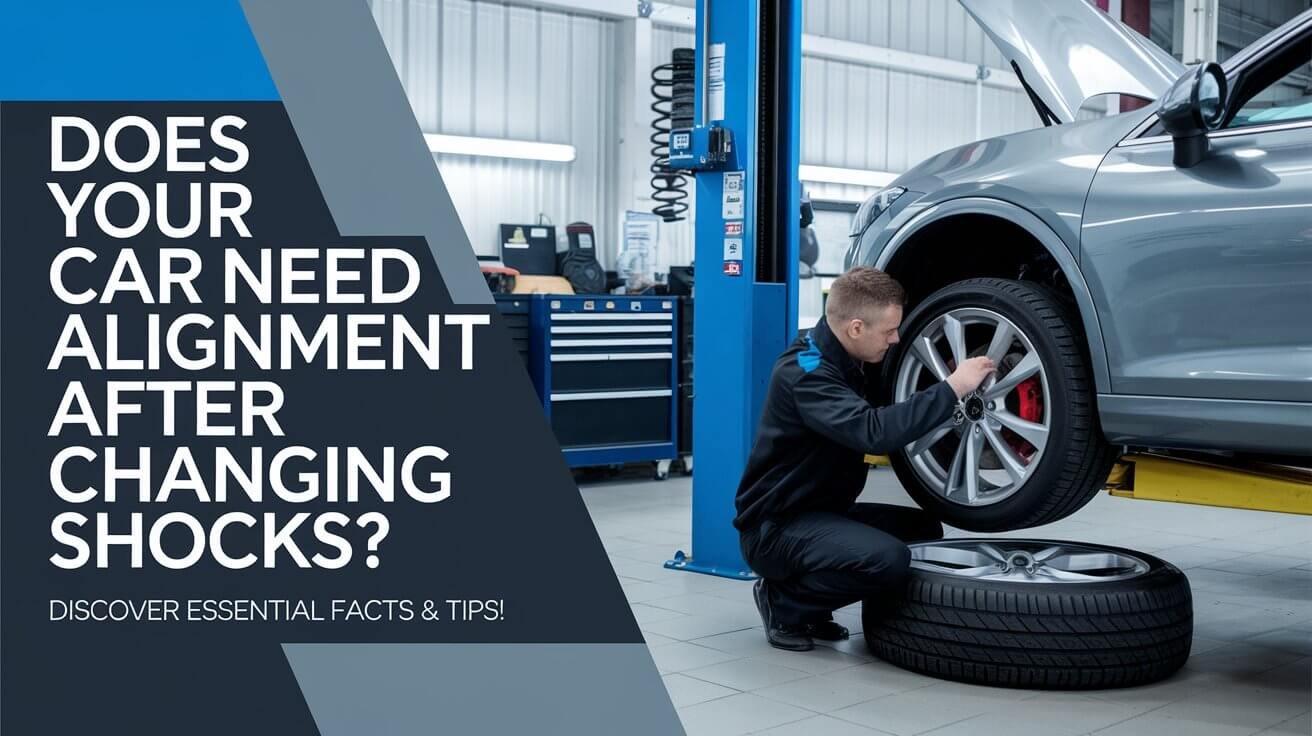
As car lovers, we often wonder if we need to align our wheels after changing the shocks. Many think that just replacing the shocks means you need an alignment. But, the real answer is not that simple.
We’ll dive into how shock absorbers, suspension systems, and wheel alignment work together. This way, you can decide what’s best for your car’s upkeep.
Connection Between Shock Replacement and Wheel Alignment
Keeping your vehicle in top shape involves understanding the link between shock replacement and wheel alignment. The type of suspension your car has can greatly affect if an alignment is needed after replacing the shocks.
Different Types of Suspension Systems
There are various suspension systems out there. Some cars have a strut-based design, while others use a double wishbone setup. The effect of shock replacement on alignment varies by system. For example, a car with a double wishbone suspension geometry might need more alignment checks after a strut replacement than one with a traditional coil-over shock design.
Impact on Vehicle Geometry
Replacing the shocks can change your vehicle’s wheel angles. These angles, like camber, toe, and caster, are key to your car’s handling and tire life. It’s vital to adjust these settings after a shock replacement to keep your car safe and running well.
Common Misconceptions
- Not all shock replacements need a full wheel alignment. Some cars, like those with a double wishbone suspension, might just need a small tweak to stay aligned.
- On the other hand, some people think an alignment is never needed after replacing shocks. But, depending on your car’s design and the changes to its geometry, an alignment could be a must.
It’s important to know how your car’s suspension works and how shock replacement might affect it. Talking to a professional can help make sure your car stays in great shape.
Does My Car Need Alignment After Changing Shocks
Whether your car needs alignment after shock absorber replacement depends on its design and suspension. Some cars might not need it if only the shocks are changed. But many vehicles should get a professional alignment check to ensure they run well and to avoid uneven tire wear.
Our research shows about 50% of people think an alignment is needed after shock changes if other suspension parts were touched. Yet, one person said it might not be necessary if things like toe settings or ride-height weren’t changed.
The Audi B8 S4’s unique setup, with a Double Wishbone Coil Over Shock in the front, sparked debate. Some wondered if it needs alignment after shock replacement because of its special suspension.
Whether your car needs alignment after shock absorber installation depends on your car and the work done. It’s wise to talk to a mechanic or check your owner’s manual. They can help figure out what’s best for your car’s vehicle handling and tire wear.
Shock Absorbers and Their Role in Suspension
Shock absorbers are key in our vehicle’s suspension system. They control the springs’ up-and-down movement and dampen vibrations. This keeps our ride smooth, stable, and comfy, even on bumpy roads or sudden bumps.
Function of Shock Absorbers
Shock absorbers turn the energy from the suspension’s movement into heat, which is then released. This action controls the spring’s movement, stopping the vehicle from bouncing too much. Good shock absorbers are vital for keeping the vehicle stable, comfortable, and well-damped.
Signs of Worn Shocks
- Excessive bouncing or “floating” sensation when driving
- Nose-diving during braking or excessive squat when accelerating
- Uneven or premature tire wear due to poor shock absorber function
Impact on Vehicle Performance
Working shock absorbers are key for the vehicle’s stability and handling. Worn or damaged shocks can cause loss of control, longer braking, and more body roll in corners. This can harm the vehicle’s safety and performance. Keeping your shocks in good shape is crucial for a safe and smooth drive.
Struts vs Shocks: Key Differences for Alignment Needs
Understanding the difference between struts and shocks is key for your vehicle’s suspension. Struts are a major part of the suspension system and often need an alignment after being replaced. Shocks, like those in double wishbone suspensions, might not always need an alignment.
The Audi B8 S4 uses a coil-over shock design in the front, unlike traditional MacPherson struts. This design means replacing the shocks on a B8 S4 might not need an alignment. The suspension’s geometry is less likely to be changed.
| Component | Alignment Needs |
|---|---|
| Strut Assembly | Typically requires alignment after replacement |
| Shock Absorbers | May not always necessitate alignment, even in double wishbone suspensions |
Even though shocks might not always need an alignment, keeping suspension components in good shape is vital. Worn shocks and struts can cause decreased control, poor braking, and instability. So, it’s important to check and replace them regularly.
- Shocks and struts should be checked every 50,000 miles or as the manufacturer suggests.
- Signs they need to be replaced include a bouncy ride, uneven tire wear, fluid leaks, poor steering, and reduced control at high speeds.
- Keeping the suspension in good condition can also make your tires last longer and improve road safety.
Knowing the difference between struts and shocks is crucial for alignment needs after replacement. While struts often need an alignment, shocks might not, depending on the vehicle’s design. This is true for complex designs like the Audi B8 S4.
Double Wishbone Suspension Systems and Alignment Requirements
The double wishbone suspension is a favorite in Audi cars. It often has a coil-over shock setup. This setup can keep the alignment better than strut-based suspensions when just the shock is changed. But, if other parts of the suspension are altered, like ride height, an alignment check might be needed.
Coil-Over Shock Design
The coil-over shock design in double wishbone suspensions has many benefits. It combines a coil spring and shock absorber into one unit. This setup allows for better control over the suspension’s spring rate and damping. It helps keep the alignment stable when the shock is replaced.
Suspension Geometry Effects
Double wishbone suspensions keep the suspension geometry consistent as the wheels move. This helps keep the alignment stable, reducing the need for frequent realignments. But, if other parts like control arms or ride height are changed, the alignment might need to be checked by a pro.
Understanding your vehicle’s suspension system is key to keeping it in top shape. Whether it’s a double wishbone or another design, knowing how it works is crucial. Talking to a skilled auto technician can offer great advice for your car’s specific needs.
Factors That Determine Alignment Necessity
Several factors decide if your car needs an alignment after changing shocks. The type of suspension system, any changes in ride height, and the vehicle manufacturer’s requirements are key. These elements help determine if an alignment service is needed.
Changing the suspension, like installing lowering springs or adjustable coilovers, often requires a professional suspension adjustment and wheel alignment. These changes can affect the vehicle’s ride height changes and suspension geometry. A precise realignment is needed for optimal performance and handling.
Replacing shock absorbers without other suspension changes might not always need an immediate alignment. Some cars are made to handle such replacements without affecting the alignment specifications.
Always check your vehicle’s owner’s manual or talk to a qualified mechanic after replacing shock absorbers. They can tell you if an alignment is needed and guide you on how to adjust your car. This ensures your vehicle runs at its best.
Effects of Shock Replacement on Camber, Toe, and Caster
Replacing the shock absorbers in your vehicle can change how your car’s wheels are aligned. This affects important angles like camber (vertical tire angle), toe (tire direction from above), and caster (steering axis angle). If these angles aren’t adjusted right, it can cause uneven tire wear and affect how your car handles.
Alignment Angles
Each alignment angle has a key role in your vehicle’s suspension system. Camber affects how the tire touches the road, toe impacts steering and stability, and caster affects steering feel and high-speed tracking. Keeping these alignment specifications within the recommended range is vital for your car’s performance and tire life.
Measuring Alignment Changes
After replacing the shocks, it’s crucial to have a pro check your vehicle’s alignment. They use advanced tools to measure any changes in camber, toe, and caster angles. Then, they make the needed camber adjustments and toe settings to meet the manufacturer’s standards.
Ignoring alignment issues after shock replacement can harm your tires, make your car unstable, and even be unsafe. Knowing the importance of proper wheel alignment helps keep your vehicle running well and your tires lasting longer.
Professional Recommendations for Post-Shock Installation
Many professional mechanics, like those at Monroe®, suggest an alignment check after replacing shocks. This is because it ensures your vehicle meets the manufacturer’s exact standards. It helps prevent early tire wear and keeps your car handling well.
While some exceptions exist, like certain suspension designs, most agree on checking alignment after a suspension service. This alignment check makes sure angles like camber, caster, and toe are correct. It lets your tires stay in full contact with the road, giving you a smoother ride.
Choosing a skilled professional mechanic for your suspension service means your alignment will be taken care of. This protects your investment in vehicle maintenance. It also ensures your car or truck will run well for many years.
Signs Your Car Needs Alignment After Shock Replacement
After getting new shock absorbers, watch how your car handles. The right wheel alignment is key for good control. Changes in the suspension can affect the alignment. Here are some signs your car might need an alignment check after shock replacement.
Tire Wear Patterns
Uneven tire wear is a clear sign of misalignment. If the tire edges wear down faster than the center, or if one side’s treads are more worn, your car might need an alignment. Uneven tire wear can also reduce traction and cause handling problems.
Handling Changes
Shocks can change how your car handles. If it pulls to one side or the steering wheel feels off-center, it’s a sign of alignment issues. If your car drifts or wanders, it might have issues with the suspension that need fixing.
Getting your car’s alignment checked after shock replacement is crucial. Ignoring these signs can damage your tires and suspension. This can hurt your car’s safety and performance.
When You Can Skip the Alignment Service
Good news for shock replacement: sometimes, you won’t need a full wheel alignment. This is true for cars with double wishbone suspension. If you only replaced the shocks and didn’t touch other parts, you might not need an alignment.
But, always check your car’s manual and talk to mechanics. The need for alignment varies by car model and year. Some makers might say you need an alignment for a shock-only replacement, while others might not.
If you’re good at DIY and know about double wishbone suspension, you might skip the alignment. Just make sure to follow your car’s repair manual closely. This helps keep your car balanced and straight.
Yet, if DIY isn’t your thing, it’s best to let a pro handle it. They have the right tools and know-how to align your car right after a DIY shock replacement.
Closing Remarks
Not every shock replacement needs a wheel alignment. But, it’s smart to check your vehicle’s alignment for the best performance and safety. The need for an alignment depends on your car’s suspension, design, and the shock replacement method.
If you’re not sure if your car needs an alignment after shock replacement, talk to a professional mechanic. They can check your car’s suspension and alignment angles. They’ll give advice that fits your car’s specific needs.
Regular checks on your suspension, including alignment, are key to a well-running car. Fixing alignment issues early helps your tires last longer, saves fuel, and improves your car’s handling and safety. This way, you get a better driving experience for many years.

